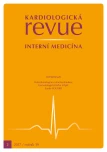Electrocardiogram and cardiac stimulation
Authors:
M. Sepši; D. Pospíšil; M. Kozák
Authors‘ workplace:
Interní kardiologická klinika LF MU a FN Brno
Published in:
Kardiol Rev Int Med 2017, 19(2): 132-137
Overview
Determining the electrical axis of the heart is the key to assessing the origin of the depolarisation wave. A normal heart axis is a vector ranging from – 30 degrees to +90 degrees. Pacing from the right ventricle apex pushes the electrical axis to the left (from – 30 degrees to more negative values). Pacing from the left ventricle moves the electrical axis to the right (from +90 degrees to positive values). Biventricular pacing leads to extreme axis deviation (from – 90 degrees to – 180 degrees). Placing a magnet over the pacemaker will cause an asynchronous pacing and thereby allows us to verify basic pacemaker functions. Placing a magnet over the implantable cardioverter-defibrillator will inhibit tachyarrhythmia therapy and can be used for temporary deactivation. Algorithms reducing right ventricular pacing allow temporary higher-grade atrioventricular blockades and thereby imitate pacing malfunction.
Keywords:
electrocardiography – pacemaker – implantable cardioverter defibrillator
Sources
1. Larsson B, Elmquist H, Ryden L et al. Lessons from the first patient with an implanted pacemaker: 1958– 2001. Pacing Clin Electrophysiol 2003; 26(1 Pt 1): 114– 124.
2. Einthoven W. Ein neues Galvanometer. Ann Phys 1903; 317(13): 1059– 1071.
3. Goldberger E. A simple, indifferent, electrocardiographic electrode of zero potential and a technique of obtaining augmented, unipolar, extremity leads. Am Heart J 1942; 23(4): 483– 492. doi: 10.1016/ S0002-8703(42)90293-X.
4. Surawicz B, Knilans T. Chou’s Electrocardiography in Clinical Practice: Adult and Pediatric. (6th ed) Philadelphia: Elsevier Health Sciences; 2008: 16– 17.
5. Jacob S, Panaich SS, Maheshwari R et al. Clinical applications of magnets on cardiac rhythm management devices. Europace 2011; 13(9): 1222– 1230. doi: 10.1093/ europace/ eur137.
6. Sweeney MO, Hellkamp AS, Ellenbogen KA et al. Adverse effect of ventricular pacing on heart failure and atrial fibrillation among patients with normal baseline QRS duration in a clinical trial of pacemaker therapy for sinus node dysfunction. Circulation 2003; 107(23): 2932– 2937.
7. Stockburger M, Boveda S, Moreno J et al. Long-term clinical effects of ventricular pacing reduction with a changeover mode to minimize ventricular pacing in a general pacemaker population. Eur Heart J 2015; 36(3): 151– 157. doi: 10.1093/ eurheartj/ ehu336.
8. Rosenbaum MB, Blanco HH, Elizari MV et al. Electrotonic modulation of the T wave and cardiac memory. Am J Cardiol 1982; 50(2): 213– 222.
Labels
Paediatric cardiology Internal medicine Cardiac surgery CardiologyArticle was published in
Cardiology Review

2017 Issue 2
Most read in this issue
- Target blood pressure values in heart failure
- New fixed antihypertensive combinations
- Electrocardiogram and cardiac stimulation
- Pharmacotherapy of heart failure with preserved ejection fraction
